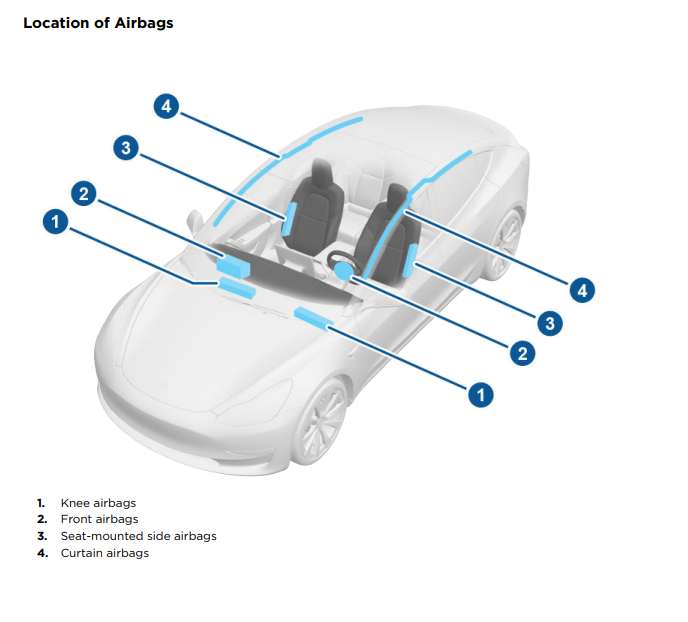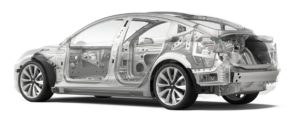At the time of Model 3 launch, Tesla said that it expects 5 star safety ratings for Model 3. Tesla CEO Elon Musk who walked his audience through a crash test video during the launch said, “The Volvo S60 is arguably the second safest car in the world”.
Tesla Model 3 has been in production for just over a year and official crash testing data from NHSTA is yet to be released, while IIHS is still testing the vehicle.
Tesla Model 3 Standard Safety Features:
-
Eight airbags (Knee, front, seat-mounted and curtain)
-
Electronic stability and traction control
-
Anti-lock braking system
-
Automatic emergency braking and collision avoidance
-
Stolen vehicle tracking
-
Automatic exterior lights
-
Blind spot sensor
-
Lane departure warning
-
Park Assist
-
Seatbelt pre-tensioners (Driver and front passenger)
-
Shoulder pre-tensioners (Rear outboard seats)
-
Child protection lock (Rear seats)
-
Tire pressure monitor
-
Interior emergency trunk release (Front and rear)
-
Range Assurance (Model 3 continuously monitors its energy level and proximity to known charging locations)
-
Speed Assist (Speed limit warning)
-
Tesla Roadside Assistance (Available 24 hours a day, 365 days a year, for the duration of warranty period).
Architecture: The position of battery pack in Tesla vehicles play a very important role in the design of the car and its safety.
Watch a Tesla Model 3 vs. Volvo S60 side-pole impact test pic.twitter.com/dXBQkstrdo
— Tesla (@Tesla) July 29, 2017
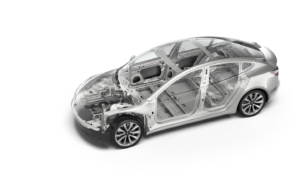 According to Tesla, the metal structure used to build Model 3 is a combination of aluminium and steel. The company says that in a roof crush test “Model 3 resisted four times its own mass, even with an all-glass roof.
According to Tesla, the metal structure used to build Model 3 is a combination of aluminium and steel. The company says that in a roof crush test “Model 3 resisted four times its own mass, even with an all-glass roof.
“The position and weight of the floor-mounted battery pack provides a very low, solid center of gravity—allowing for a low rollover”. – Tesla
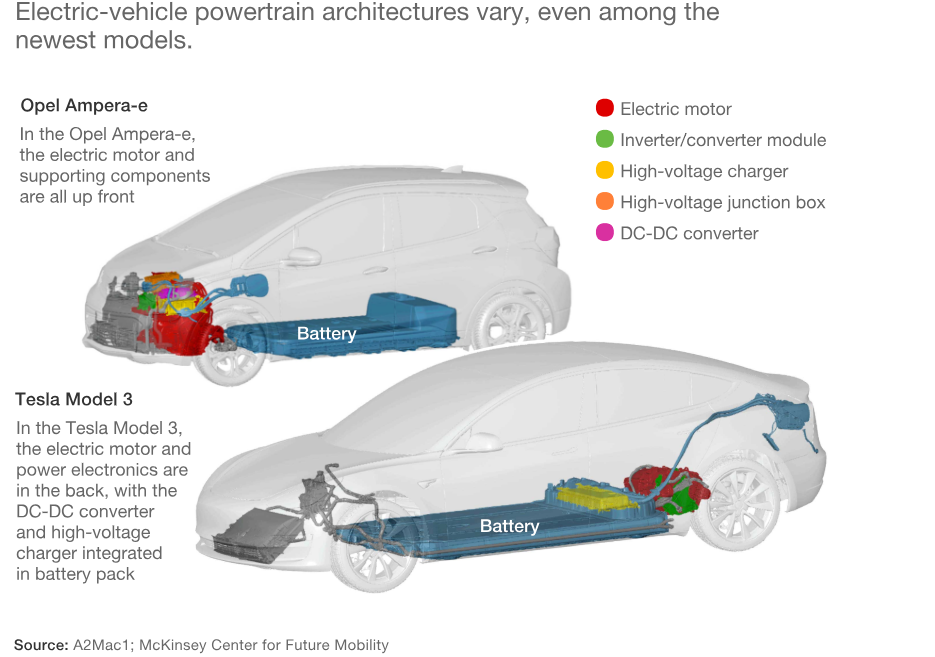
To give just one example of different EV powertrain architectures: the Opel Ampera-e seems to leverage an ICE-like positioning of its powertrain electronics, including ICE-typical body and axle components, whereas the Tesla Model 3 integrated most components on the rear of its battery pack and the rear axle directly (Exhibit 5).
It is worth pointing out that such freedom in the positioning of components also gives more flexibility in overall features offered, for example, choosing to have room for a bigger trunk or to offer superior driving performance due to a lower center of gravity. – Mckinsey
Tesla’s new 2170 battery cells, which according to CEO Elon Musk has the highest energy density, reduced the weight of the battery pack without sacrificing the car’s range. Model 3 battery pack is 15% lighter than Model S 85 kWh battery and 6% lighter than Model S P100D.

According to InsideEVs, “In the Model S, the heavy battery case provides the crash protection for the battery with minimal high strength steel. The case in model S is solid metal ¼” thick.”
But Tesla made a lot of structural changes to Model 3 design. Unlike Model S, AC Charger and DC converter are integrated in Model 3’s battery pack. Model 3 now uses high strength steel in the body to protect the battery pack from impact.
The Insurance Institute for Highway Safety (IIHS) initial Tesla Model 3 safety results:
The IIHS, which is still conducting Model 3 crash and safety testing released two (front crash prevention and headlights) out of seven ratings in May 2018. The Institute recently examined driver assistance features of Tesla Model S, Tesla Model 3, BMW 5 Series, Mercedes-Benz E-Class, and Volvo S90, and released its findings on August 7th, 2018.
Tesla Model 3 received “Superior” (highest possible rating) and “Acceptable” rating for front crash avoidance and Headlights respectively.
IIHS on Model 3 Headlights:
Low beams: On the straightaway, visibility was good on the left side of the road and inadequate on the right side. On curves, visibility was fair in all 4 tests. The low beams created some glare.
High beams: On the straightaway, visibility was good on the right side of the road and fair on the left side. On curves, visibility was good on the gradual right curve and fair on the sharp right and both left curves. High-beam assist compensates for some limitations of this vehicle’s low beams on the straightaway and all 4 curves.
IIHS on Model 3 Driver Assistance Features:
Curves and hills can challenge active lane-keeping systems. The Tesla Model 3 performed well in these on-road tests. The E-Class stayed in its lane in 15 of 18 trials and on the line in one trial, continuously providing steering support without erratic moves when lane lines weren’t visible. The Model 3 also stayed in the lane in all but one trial, when it hugged the line.
Unnecessary or overly cautious braking is an issue IIHS noted in the Model 3. Out on the road, engineers noted instances in which each vehicle except the Model 3 failed to respond to stopped vehicles ahead. Unnecessary or overly cautious braking is an issue IIHS noted in the Model 3.
In 180 miles, the car unexpectedly slowed down 12 times, seven of which coincided with tree shadows on the road. The others were for oncoming vehicles in another lane or vehicles crossing the road far ahead.
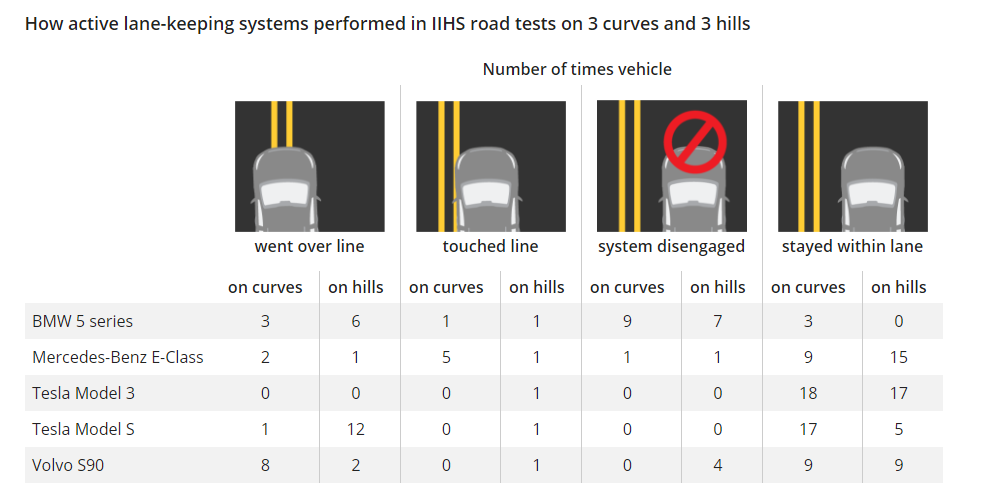
Tesla Model 3 Specification and Safety Features in Pictures:

